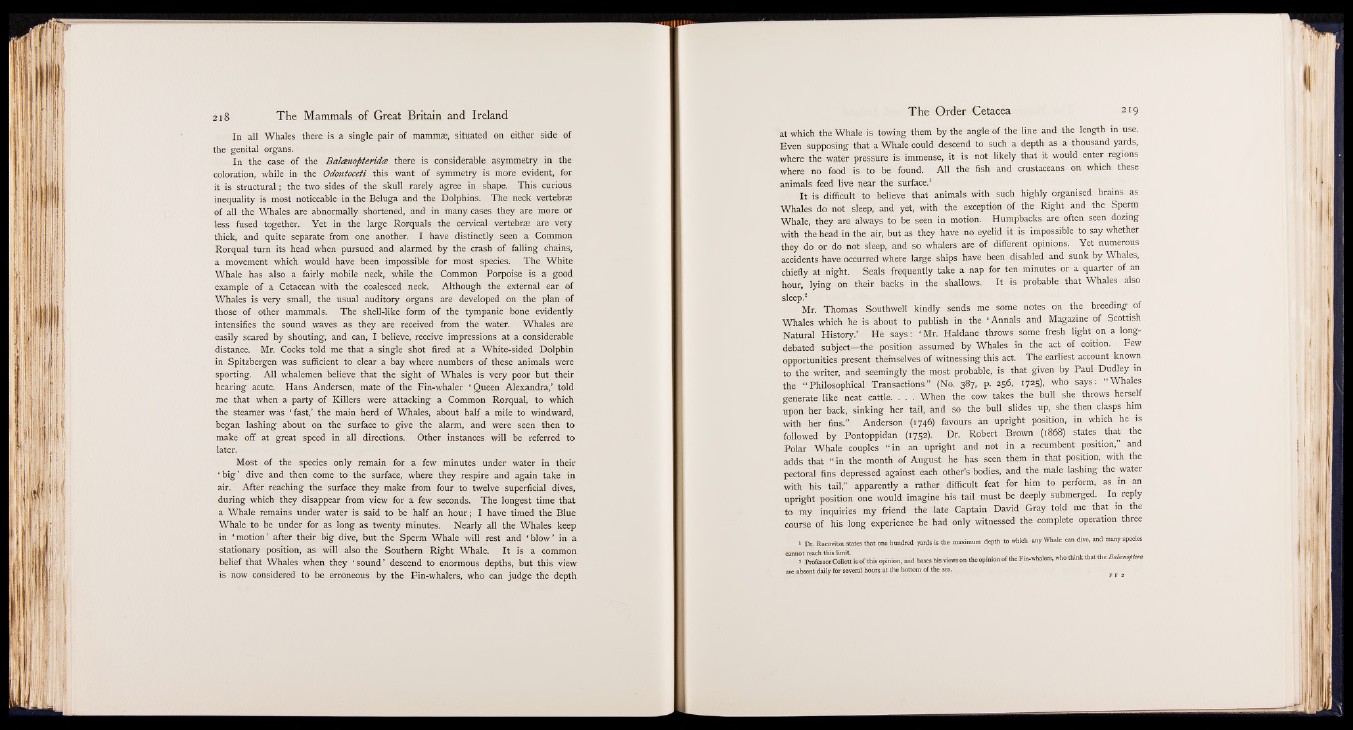
In all Whales there is a single pair of mammae, situated on either side of
the genital organs.
In the case of the Balcenopteridce there is considerable asymmetry in the
coloration, while in the Odontoceti this want of symmetry is more evident, for
it is structural; the two sides of the skull rarely agree in shape. This curious
inequality is most noticeable in the Beluga and the Dolphins. The neck vertebrae
of all the Whales are abnormally shortened, and in many cases they are more or
less fused together. Yet in the large Rorquals the cervical vertebrae are very
thick, and quite separate from one another. I have distinctly seen a Common
Rorqual turn its head when pursued and alarmed by the crash of falling chains,
a movement which would have been impossible for most species. The White
Whale has also a fairly mobile neck, while the Common Porpoise is a good
example of a Cetacean with the coalesced neck. Although the external ear of
Whales is very small, the usual auditory organs are developed on the plan of
those of other mammals. The shell-like form of the tympanic bone evidently
intensities the sound waves as they are received from the water. Whales are
easily scared by shouting, and can, I believe, receive impressions at a considerable
distance. Mr. Cocks told me that a single shot fired at a White-sided Dolphin
in Spitzbergen was sufficient to clear a bay where numbers of these animals were
sporting. All whalemen believe that the sight of Whales is very poor but their
hearing acute. Hans Andersen, mate of the Fin-whaler ‘ Queen Alexandra,' told
me that when a party of Killers were attacking a Common Rorqual, to which
the steamer was ‘ fast,’ the main herd of Whales, about half a mile to windward,
began lashing about on the surface to give the alarm, and were seen then to
make off at great speed in all directions. Other instances will be referred to
later.
Most of the species only remain for a few minutes under water in their
‘ big ’ dive and then come to the surface, where they respire and again take in
air. After reaching the surface they make from four to twelve superficial dives,
during which they disappear from view for a few seconds. The longest time that
a Whale remains under water is said to be half an hour; I have timed the Blue
Whale to be under for as long as twenty minutes. Nearly all the Whales keep
in ‘ motion’ after their big dive, but the Sperm Whale will rest and ‘ blow’ in a
stationary position, as will also the Southern Right Whale. It is a common
belief that Whales when they ‘ sound’ descend to enormous depths, but this view
is now considered to be erroneous by the Fin-whalers, who can judge the depth
at which the Whale is towing them by the angle of the line and the length in use.
Even supposing that a Whale could descend to such a depth as a thousand yards,
where the water pressure is immense, it is not likely that it would enter regions
where no food is to be found. All the fish and crustaceans on which these
animals feed live near the surface.1
It is difficult to believe that animals with such highly organised brains as
Whales do not sleep, and yet, with the exception of the Right and the Sperm
Whale, they are always to be seen in motion. Humpbacks are often seen dozing
with the head in the air, but as they have no eyelid it is impossible to say whether
they do or do not sleep, and so whalers are of different opinions. Yet numerous
accidents have occurred where large ships have been disabled and sunk by Whales,
chiefly at night. Seals frequently take a nap for ten minutes or a quarter of an
hour, lying on their backs in the shallows. It ' is probable that Whales also
sleep.3
Mr. Thomas Southwell kindly sends me some notes on the breeding of
Whales which he is about to publish in the ‘ Annals and Magazine of Scottish
Natural History.’ He says: ‘ Mr. Haldane throws some fresh light on a long-
debated subject— the position assumed by Whales in the act of coition. Few
opportunities present themselves of witnessing this act. The earliest account known
to the writer, and seemingly the most probable, is that given by Paul Dudley in
the “ Philosophical Transactions ’’ (No. 387, p. 256, 1725), who says: “ Whales
generate like neat cattle. . . . When the cow takes the bull she throws herself
upon her back, sinking her tail, and so the bull slides up, she then clasps him
with her fins.” Anderson (1746) favours an upright position, in which he is
followed by Pontoppidan (1752). Dr. Robert Brown (1868) states that the
Polar Whale couples “ in an upright and not in a recumbent position,” and
adds that “ in the month of August he has seen them in that position, with the
pectoral fins depressed against each other’s bodies, and the male lashing the water
with his tail,” apparently a rather difficult feat for him to perform, as in an
upright position one would imagine his tail must be deeply submerged. In reply
to my inquiries my friend the late Captain David Gray told me that in the
course of his long experience he had only witnessed the complete operation three
> Dr. Racovitra states that one hundred yards is the maaimum depth to trhich any Whale can dive, and many species
cannot reach this limit , . . . . . . . . . „ . .,
> Professor Collett is of this opinion, and bases his views on the opinion of the Fin. whalers, who think that the Batouopttra
are absent daily for several hours at the bottom of the sea.